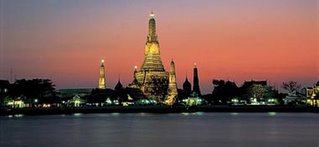Sukhothai
Found in the 13th century, Sukhothai (literally means Dawn of Happiness) was the first truly independent Thai Kingdom, which enjoyed a golden age under King Ramkhamhaeng, credited with creating the Thai alphabet. The superb temples and monuments of this great city have been lovingly restored in Sukhothai Historical Park, a UNESCO World Heritage Site and a must-see for all travellers.
Sukhothai is located on the lower edge of the northern region, 427 kilometres north of Bangkok or some 298 kilometres south of Chiang Mai. The province covers some 6,596 square kilometres and is divided into 9 Amphoes: Muang Sukhothai, Ban Dan Lan Hoi, Khiri Mat, Kong Krailat, Sawankhalok, Si Nakhon, Si Samrong, Si Satchanalai and Thung Saliam.
HISTORICAL BACKGROUND
Sukhothai was the first kingdom of the Thais in this peninsula. Two princes-Pho Khun Pha Muang and Pho Khun Bang Klang Hao combined their forces and fought the Khmers who commanded an extensive empire throughout this part of the world.
They drove the Khmers out of Sukhothai, a major frontier post of the Khmer Empire, and established it as their capital in 1238. Pho Khun Bang Klang Hao, urged by the people to be king, was enthroned with the royal title of Pho Khun Si Indrathit.
King Si Indrathit had two sons-Pho Khun Ban Mueang and Pho Khun Ramkhamhaeng. After his death, Pho Khun Ban Mueang succeeded him. His brother, Pho Khun Ramkhamhaeng, ascended the throne in 1278 and reigned for forty years. He was Thailand's first great king.
One of Thailand's finest warriors, King Ramkhamhaeng made Sukhothai a powerful and extensive kingdom which included many parts of what are today neighbouring countries. A number of ancient cities paid him tribute.King Ramkhamhaeng opened direct political relations with China and made two trips to China - the first in 1282 to visit Emperor Kublai Khan and the second in 1300 after Kublai Khans death.
From the second visit, he brought back Chinese artisans who taught the Thais the art of pottery. Today, the old Sangkhalok Potteries are eagerly sought by collectors.
A major achievement of King Ramkhamhaeng was the revision of various forms of Khmer alphabets into a system suitable for the writing of Thai words. The alphabet that he invented in 1283 was essentially the same as that in use today.During his reign, there was prosperity and happiness. There was water in the paddy-fields and fish in the water.
A stone inscription reads in part, This Muang Sukhothai is good. In the water there are fish; in the field there is rice. The ruler does not levy a tax on the people who travel along the road together, leading their oxen on the way to trade and riding their horses on the way to sell. Whoever wants to trade in elephants, so trades. Whoever wants to trade in horses, so trades. Whoever wants to trade in silver and gold, so trades.
King Ramkhamhaeng also promoted religion and culture, and through his efforts, Buddhism progressed among the people. Inspirational faith gave birth to classic forms of Thai religious arts. Images of the Lord Buddha sculptured during the Sukhothai Era are cultural treasures which impart a feeling of peace and serenity.
A total of eight kings ruled Sukhothai. The gradual decline of Sukhothai occurred during the reigns of the last two kings. The end of this first Thai kingdom occurred in 1365 when it became a vassal state of Ayutthaya, a young and rising power to the south. Ayutthaya became the capital of Thailand before Thon Buri and Bangkok.


